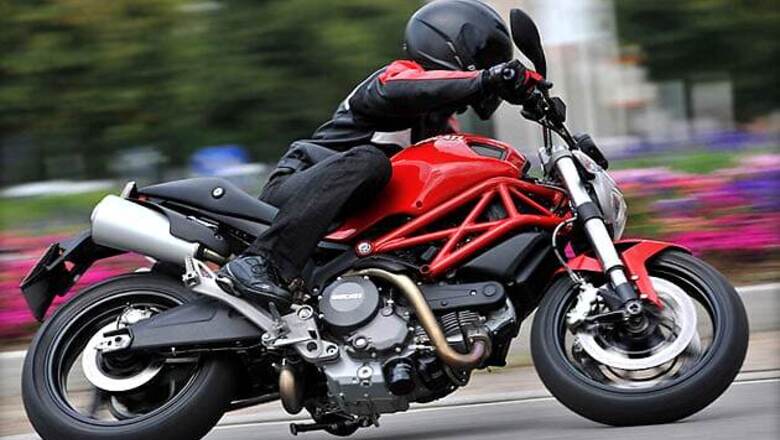
views
What is it?
The Ducati Monster 795 can be looked at as an example of cheeky engineering on the one hand and a 30-foot neon sign that points to the direction Ducati is looking forward to for future growth and prosperity.
The first bit refers to the clever engineering. Ducati needed a more affordable, but still undeniably premium, and unequivocally Ducati motorcycle for its Asian markets, some of the fastest growing two-wheeler markets in the world. What they have done is take the chassis from the entry level Monster, the 696 and slot into it the virtually unchanged 803cc engine from the 796 and created the 795. It's a clever solution that requires relatively little engineering and which produces an eminently acceptable solution to the issue.
The second bit refers to this Monster being the first time in their history that Ducati have created a motorcycle targeted to a specific geographical region and it's customer profile. It's a strategic move that highlights just how important the Borgo Panigale based manufacturer thinks Asia is to its future.
Is it just a chassis-engine hybrid?
Well, no. In the process of mating the lower, smaller 696 trellis frame and it's components to the 87PS, 78Nm 803cc L-twin from the 796, Ducati also made some ergonomics related changes that add up to more than the sum of its parts. The seat height compared to the 796 is lower, and the handlebar is taller by 20mm. This together creates a less committed, less sporty riding position. On a 180km ride along town roads, highways and windy B-roads, the Monster proved to have a typically sporty riding position, but the 795 was surprisingly light on the wrists, even when crawling through traffic at low speeds. Ducati say that the 796 would feel more sporty and committed ridden back to back and that the 795 is more suited to the Asian markets where a lot of customers would use them regularly around town where this ergonomic package would really be a boon. I would have to agree that if I, or lucky you for that matter, were to commute daily in our traffic to work on 795, a sweeter balance between sporty commitment and ergonomic comfort would be difficult to achieve.
Where is it made?
Ducati opened the doors of its Thailand factory in November last year and that is where the 795, and for now, only the 795 will be manufactured. The kits come from Italy in the large part but 12 per cent of the motorcycle is localised, mostly referring to the wiring harness and other electrical bits. In Thailand, we were given to understand, that localisation is defined by legislation as parts sourcing from the ASEAN region. So some of these parts come from other countries, like the handlebar, a steel bar comes from India. The assembled motorcycle will be imported from Thailand to India leveraging the free trade agreement that Thailand and India have in place. We were told this cuts the duty implication from 60 to 20 per cent, and discussions are on that will shortly drop this to just 10 per cent. Thailand will also export the motorcycle to other Asian markets. Just so you know, China was the fastest growing Ducati market in 2011 in Asia (Japan is not considered in this statistic) while India is already the fifth fastest growing Ducati market.
What is the difference between the 796 and the 795?
The core differences lie in the chassis. The front tyre on the 795 is a lower profile while the rear tyre is narrower and mounted on a narrower rim. The wheels, also locally sourced, are three spoke alloy units from the 696. There is obviously the twin sided cast aluminium swingarm, versus the single sided job from the 796. Plus some other minor bits, like the steel handlebar versus the aluminium bar from the 796. Together it allows Ducati to make the Monster more affordable without losing the essential appeal or nature of the motorcycle. While the Thai assembly operation allows them to significantly reduce duty implications in all of its Asian markets, which is why the 2.5-lakh rupee price difference to the customer between the 796 and the 795. Ducati confirmed that the 796 sales will close once current stock is sold out and that the 795 will be the new replacement entry-Monster for India.
Will other Asian Ducatis like this also arrive to tempt us?
It makes sense that they will. The Hypermotard, for instance, is ripe for the picking as it were. Officially, Ducati officials agreed to the making sense bit but said the response to the Monster would set the course, and they are expecting a good response to the motorcycle in all of the Asian markets. Meanwhile, Ducati is also working on expanding its Indian distribution and after sales channels, critical to volume growth as well as improving its reach to the Indian customer.
What is the price?
Ducati officially launched the Monster 795 at the Auto Expo in January at Rs 6.99 lakh ex-Delhi, then announcing an introduction price of Rs 5.99 lakh for the first 300 units. The documentation at the launch says that Ducati's telemetry system, DDA (telemetry data can be downloaded from the motorcycle via USB and analysed on a computer using its accompanying software) is optional and ABS is available upon request. No prices were offered on these at this time.
What does it compete against?
Well, the Monster created the well-populated sport naked segment way back in 1993. Today in India, it has only the Kawasaki Ninja 650R, priced a bit below the 795 for competition. And perhaps the much cheaper, but also far less powerful Hyosung GT650N. Note that the Ducati has a significant displacement advantage over both. Triumph has also announced the Street Triple which will come at approximately Rs 5.75 lakh ex-showroom, though launch timing is not yet confirmed. The Street Triple will be serious competition, because of its blend of pricing and performance.


















Comments
0 comment